While we were in Greece we both ordered the same thing for lunch every day: a big, fat Greek salad. The blend of ingredients was so simple and so refreshing that we just couldn’t get enough of them.
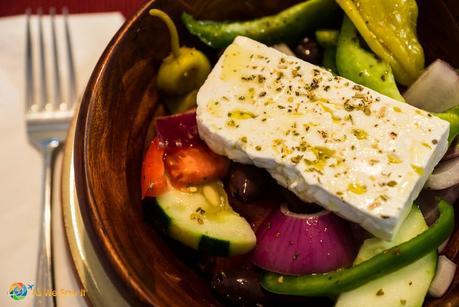
This is the classic salad of the country, known and eaten everywhere in Greece. They are so well-known worldwide that they are actually called “Greek salads” overseas. Within the country, though, Greek salad is called horiatiki salata, “rustic salad.” Rather fitting, I think, because practically everyone in the whole country knows how to make it.
So now that we have eaten it in Greece, we now know how to make an authentic Greek salad, too. Read on for the horiatiki salata recipe.
Being a cheese fiend, I fell in love with horiatiki as soon as I discovered that it always comes with a massive slab of sheep’s milk feta cheese on top. Also a plus: In an authentic salad there is no lettuce in sight, just big chunks of juicy tomatoes, crunchy cucumbers and pungent onions glistening with fragrant, emerald olive oil.
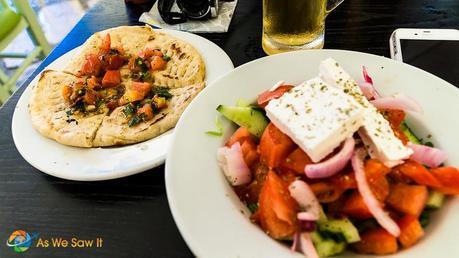
How to eat Greek salad
Regardless of the restaurant, our horiatiki always arrived at the table the same way: in two shallow bowls, one for each of us. There was always a plate too, in case we didn’t want to eat straight from the serving bowl. Except for the one time we were each served a family-sized salad, we preferred to ignore the plates and eat straight from the bowl, breaking off and then spearing a salty chunk feta along with a veggie or two. We didn’t want to risk losing any of the peppery oil or errant salty morsels of feta that escaped our forks and made their way to the bottom.
I’ll confess that despite my wheat sensitivity I still sometimes succumbed to the temptation of the freshly baked, pita-shaped breads that accompanied our salads. It was hard to resist breaking off a few pieces of the crusty bread to soak up those last drops of feta/olive oil/oregano/vegetable liquid deliciousness that remained behind in the bowl.
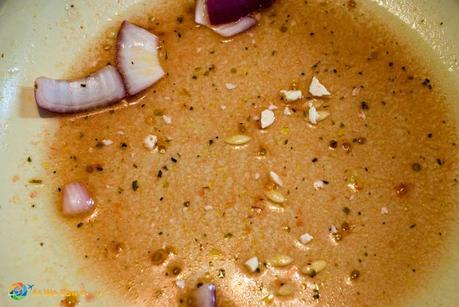
Fortunately, that’s a typically Greek thing to do. They do it so often they even have a name for it: papara. As one person told us, it’s a perfectly acceptable custom in Greece, and you can only say you’ve eaten a horiatiki salad properly if you have made a papara.
The custom in Greece, at least among families and good friends, is to prepare one large plate of horiatiki salata for the table to share. Everyone can eat out of the communal plate and join in the papara at the end.
That said, some people do prefer to take their own portion on their own plate, and most restaurants, especially in tourist areas, provide extra plates for those who want to divide the salad. So now that’s now how we do it when we make it at home. (Besides, it’s easier.)

The horiatiki salata recipe
Using the word “recipe” is stretching it a bit, but among Greeks there’s a strict, unspoken rule about what is allowed to go into it. It should contain only feta cheese, tomatoes, cucumbers, onions, peppers, kalamata olives, olive oil, and oregano. That’s it. If you add anything else to the mix, they claim, it won’t be a horiatiki salad.
Okay, maybe so, but certain regions of Greece like to serve it with a splash of red wine vinegar (I’m looking at you, Thessaloniki and Crete). And that’s all I’m saying; you can take sides below in the comment section.
Tip: To get a better chance of getting an authentic, traditional Greek salad at a Greek restaurant (with no lettuce), order a horiatiki, rustic or village salad instead of a “Greek salad.”
Tips for the most authentic Greek salad
As with most simple dishes, the better the ingredients, the better the result. This is a summer salad, best made when its ingredients can be picked fresh from the garden so if you’re a vegetable lover you’ll probably want to avoid those flavorless tomatoes that begin to show up after the first frost. You should also use ingredients from Greece for the truest Greek flavor possible.
- Feta cheese. Made in Greece from sheep’s milk and served in a single slab, not cubed or crumbled. Feta made from cow’s milk is not as creamy, not as flavorful, and most of all, not authentic.
- Tomatoes. Most people will agree that the quality of a tomato can make or break any salad, so be sure to select the most fragrant, vine-ripened ones you can.
- Purple onions. Also known as red onions, they are mild, colorful and naturally sweeter.
- Cucumbers. Crunchy, fresh and juicy, sometimes peeled, sometimes not.
- Green peppers. Never the sweeter red or yellow varieties. Some prefer to use banana pepper slices or peperoncini.
- Kalamata olives. Plump and shiny, preferably with the pit still in.
- Extra-virgin olive oil. A salad this fresh and light merits one of the flavorful, dark green olive oils of the region.
- Greek oregano. Greek oregano is different from the stuff you get in pizza parlors. Go ahead and buy some. I’m sure you’ll agree.
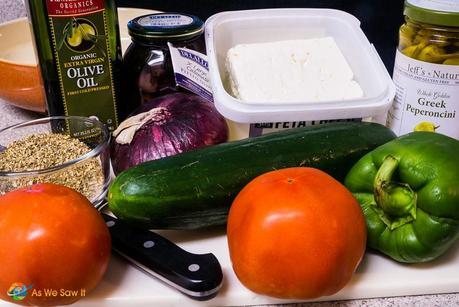
What a real Greek salad does not have
As with most dishes, it’s as much about what’s not in this salad as what is. Here are the biggest no-nos:
- Lettuce. Any chef who includes lettuce in his “Greek salad” is either ignorant or is trying to economize by filling the salad plate with less expensive ingredients.
- Feta crumbles. Real Greek salads have a huge slab of feta on top which, by the way, provides a whole lotmore protein than you would get from a couple of tablespoons of crumbled cheese. (It also costs the restaurant more. Just saying.)
- Croutons. Horrors! All bread must be served on the side for making a papara!
- Meat. Of any type.
- Potato salad. Restaurants around Tarpon Springs, a Greek community north of Tampa, Florida, always serve their Greek salads with a scoop of mayonnaise-laden potato salad. (Seriously! That’s a worse sin than croutons!)
- Parsley or lemon. It’s true that Greeks put lemon and parsley in many of their foods, but not in this salad. (They do use them in Cyprus, but then Cypriots also use shredded cabbage and omit the olives which, obviously, makes it a different salad recipe entirely.)
If you would like us to include more about foods and recipes on As We Saw It, please let us know in the comments and share this post with your friends.
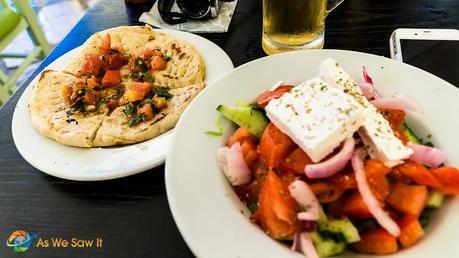
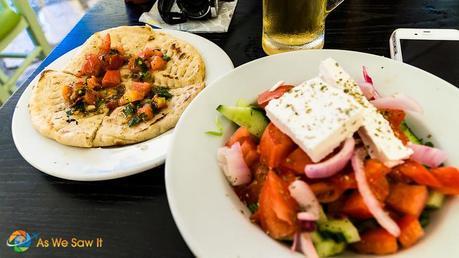
- 2 large, ripe tomatoes, cut into wedges or chunks
- 1 cucumber, washed and sliced (peeling optional)
- ½ green bell pepper, cut into thin rings or strips
- ½-1 medium red onion, thinly sliced
- 12 plump, juicy Kalamata olives, not pitted
- 2 tbsp. extra-virgin olive oil (to taste)
- 4 oz. feta cheese, divided into 2 slabs
- 2 tsp. dried Greek oregano
- 1 tsp. sea salt (to taste)
- Place tomato pieces in shallow bowls and sprinkle with salt.
- Add cucumbers, peppers, onions and olives and sprinkle with a little more salt. (Be a bit sparing; the feta is salty as well.)
- Drizzle olive oil over everything, then sprinkle with some dried Greek oregano.
- Top with feta cheese. Drizzle a bit more olive oil on the Feta and garnish with another sprinkle of Greek oregano.
- This salad is best prepared just before serving.
- Optional: provide bread and extra olive oil for dipping

